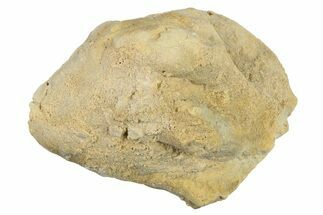5.4" Silurian Fossil Crinoid (Scyphocrinites) Lobolith - Morocco
This is a lobolith (Camarocrinus) fossil from the Upper Silurian-aged marine deposits of Erfoud, Morocco. It belongs to the crinoid species Scyphocrinites elegans.
Comes with a display stand.
A lobolith, or crinoid "float", is the bulbous root of a crinoid that served to some extent as a swimming apparatus, holding the crinoid stem and calyx in an upside down position in the water. The lobolith was chambered and likely filled with a gas produced by the crinoid to regulate its position within the water. This allowed the animal to float with the currents and move up and down in the water column. Considering most crinoids were held in place by a root-like system (holdfast), these loboliths are unique to a specific type of crinoid.
Paleontologists debated for years as to whether these loboliths were parts of one animal or their own entity. The diameter of the stem proximal to the lobolith was discovered to be much smaller than that of the stem proximal to the calyx of Scyphocrinites. This led researchers to believe they were of two separate genera, so loboliths were placed under the genus Camarocrinus. It was later shown that Scyphocrinites stems could possibly have tapered from the calyx to the bulb. Given multiple occurrences of loboliths (Camarocrinus) and Scyphocrinites calyxes in the same beds, often found entangled in each other, the suggestion that the two are from the same animal has enough evidence to give support to current taxonomic conventions.
Scyphocrinites crinoids are quarried around Erfoud, Morocco by digging straight down 16 feet (5 meters) until the layer is reached. Once the crinoid horizon is located, a tunnel is dug along it by hand. The rock, dirt, and crinoid slabs must then be hauled to the surface in baskets, where they are reassembled and prepared.
Comes with a display stand.
A lobolith, or crinoid "float", is the bulbous root of a crinoid that served to some extent as a swimming apparatus, holding the crinoid stem and calyx in an upside down position in the water. The lobolith was chambered and likely filled with a gas produced by the crinoid to regulate its position within the water. This allowed the animal to float with the currents and move up and down in the water column. Considering most crinoids were held in place by a root-like system (holdfast), these loboliths are unique to a specific type of crinoid.
Paleontologists debated for years as to whether these loboliths were parts of one animal or their own entity. The diameter of the stem proximal to the lobolith was discovered to be much smaller than that of the stem proximal to the calyx of Scyphocrinites. This led researchers to believe they were of two separate genera, so loboliths were placed under the genus Camarocrinus. It was later shown that Scyphocrinites stems could possibly have tapered from the calyx to the bulb. Given multiple occurrences of loboliths (Camarocrinus) and Scyphocrinites calyxes in the same beds, often found entangled in each other, the suggestion that the two are from the same animal has enough evidence to give support to current taxonomic conventions.
Scyphocrinites crinoids are quarried around Erfoud, Morocco by digging straight down 16 feet (5 meters) until the layer is reached. Once the crinoid horizon is located, a tunnel is dug along it by hand. The rock, dirt, and crinoid slabs must then be hauled to the surface in baskets, where they are reassembled and prepared.
Crinoids, sometimes commonly referred to as sea lilies, are animals, not plants. They are echinoderms related to starfish, sea urchins, and brittle stars. Many crinoid traits are like other members of their phylum; such traits include tube feet, radial symmetry, a water vascular system, and appendages in multiples of five (pentameral). They first appeared in the Ordovician (488 million years ago) and some species are still alive today.
$19
SPECIES
Scyphocrinites elegans
LOCATION
Boutschrafin, Erfoud, Morocco
SIZE
5.4 x 5.3 x 3.5"
CATEGORY
SUB CATEGORY
ITEM
#257094
We guarantee the authenticity of all of our specimens.
 Reviews
Reviews











